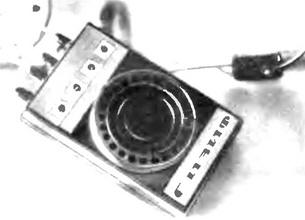Difficult for the uninitiated to understand anglers who sit all day as hypnotized, with a fishing rod, not taking her eyes off of the float. Of course, patience in eventually lost even the most avid, especially if the fish are not often happy bite. Therefore, many are experimenting, experiencing different in practice fit, indicating a bite. Considerable help in providing electronics. An example of this is a simple electronic device, which you can monitor at once for four fishing rods - the bite on any of them you will be notified light and sound signals. The indicator can be used fishing from shore, from boats and off the ice, determining the time of the bite on any of the four fishing rods in the evening and at night, and stay on some distance from the place of fishing.
The principle of the indicator is simple. On the rod in the vicinity of the coil is attached to the sensor (Fig. 1), which when biting relief of line closes the contact pair comprising a power electronic device, - lights up a corresponding lamp, and at the same time the alarm sounds.

Fig. 1. Snap-in rods
Sensor design can be varied. For example, suitable switches type MP5, MPA or closing of the contact pair from any relays. In a pinch the sensor is easy to make yourself. To do this, take two elastic metal (for example, bronze) plate length of 50-80 mm and a width of 5 mm From one end in them drill holes Ø 2 mm by copper rivets, performing the role of the contactor. In the same place to the top plate of the sensor is too small for a ring of the transmission line. At the other end in the plates drilled hole Ø 0,8-1 mm for connecting wires, and then, departing from the end of the 10 and 18 mm, drill two holes Ø 3 mm for fixing screws. The node is going to use the insulating strips of the PCB or Micarta, the thickness of which depends on the gap between the plates. When assembling the mounting hole injected insulation tube (rod segments ballpoint pen), and insert the screws, with by which the sensor is attached to, mounted on the rod sleeve. Instead you can use metal brackets, clamps, etc.
The electrical circuit of the indicator (Fig. 2) economical, it does not contain scarce parts and can be repeated any novice radio Amateur. Generator a sound signal collected by a known scheme on two different transistors patterns: VT1 - any series MP39-MP42, VТ2 - series MP-MP, KT315; diodes VD1-VD4 type D2, D9 with any letter index; resistor - MLT or sun power 0,125 W, capacitor - MBM, the dynamic head of BA1 - any brand power 0.1 to 0.25 W incandescent lamp HL1 - HL4 2.5 V (0.15 A) - pocket lights; power source - three elements RC or battery voltage 4.5 V; connecting wire mgshv cross-section of 0.2 mm2.

Fig. 2. Schematic diagram of the detector elements XP1-xp4, you, SA1-SA4 mounted on the fishing rod)
The indicator is assembled in a plastic case the size of HH mm, for example, from pocket radio (see photo). The arrangement of the elements within the housing shown in figure 3. Dynamic head is attached directly to the lid, which drilled the holes for the passage of sound. In the lid are drilled four holes against indicator bulbs; they are closed top transparent overlays of Plexiglas or polystyrene. To eliminate the influence light adjacent lamps, they are isolated by an opaque partition walls, for example from sheet or in the form of paper tubes, when placed on the cylinders of the lamps.

The appearance of the indicator

Fig. 3. The arrangement of the elements in the unit
To reduce the size of the device, all elements, except lamps and connectors can to fit in the space under the diffuser dynamic heads.
To connect the sensors with indicator better through the connectors used to connect small phones to transistor radios. When fishing from a boat and with ice connection cables should have a length of 1.5-3 m, when fishing from the shore her can be increased to 10 m.
The indicator requires no adjustment and proper installation begins to work immediately. However, you should adjust the gap between the contact plates of the sensor. It is known that in winter the fish takes the nozzle more sluggish than in summer, and that big fish biting more energetic than small ones. On this basis, and the selected size of the gap between the contacts.
Author: S. Malinowski






